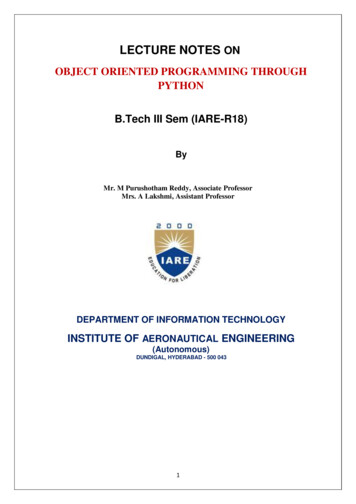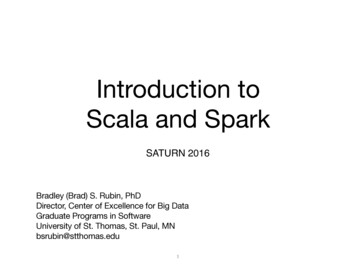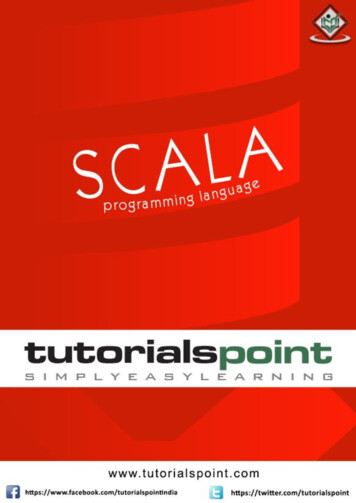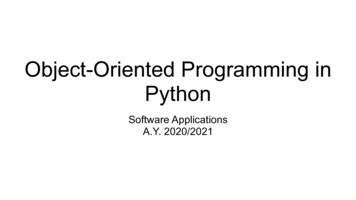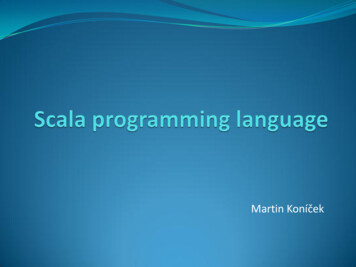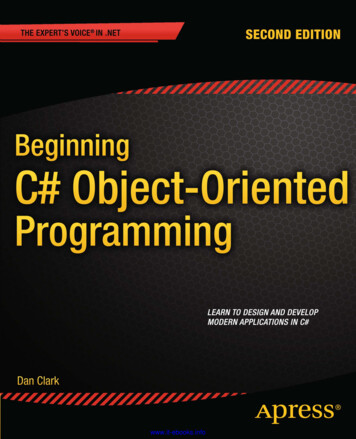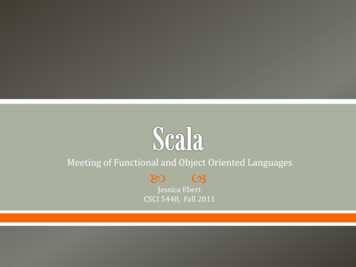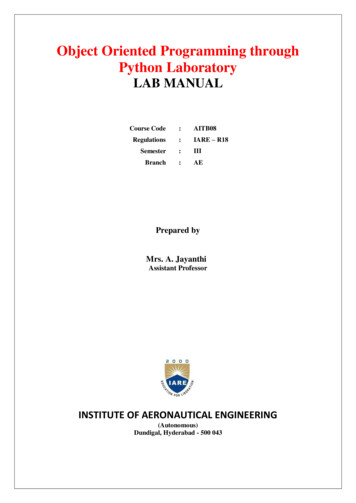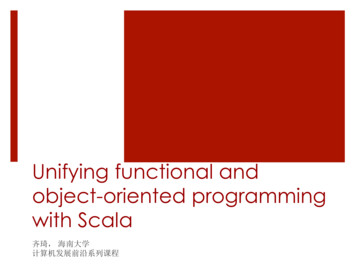
Transcription
Unifying functional andobject-oriented programmingwith Scala齐琦, 海南大学计算机发展前沿系列课程
2原文引用¡ Odersky, M. and T. Rompf (2014)."Unifying functional and objectoriented programming with Scala."Communications of the ACM 57(4):76–86.齐琦
3SCALA的发展¡ Conceptual development by Martin Odersky—2001 at EPFL¡ First internal version – 2003¡ First public release – 2004¡ Slightly redesigned language¡ A new compiler, written completely in Scala itself¡ Shortly thereafter¡ Open-source software, (Lift Web framework)¡ In industry¡ Twitter(2008),rewrote its message queue in Scala, and much of itscore software; contributed open-source and teaching materials(30 projects)¡ LinkedIn, Scala for its social graph service¡ Klout, uses Akka and Play Web framework¡ Foursquare, for its server-side systems¡ Other large enterprises: Intel, Juniper Networks, and MorganStanley齐琦Quick adoption byindustry¡ 2.x series – 2006
Reason of attractiveness¡ Scala is a pragmatic language¡ Focus is to make developers more productive¡ Statically typed, compiles to the same bytecodes asJava, and runs at comparable speed on the JVM¡ Compromises followed from the interoperability¡ Adopts Java’s method overloading scheme, eventhough exists better ones¡ Null pointers though avoided in favor of Option type¡ Rides and drives to some degree, on the emergingtrend of combining functional and object-orientedprogramming¡ FP’s emergence¡ Increasing importance of parallelism and distribution incomputing¡ Re-playable operations on immutable data, instead ofrequiring logs or replication to updates¡ Integration leads to scalable (the same concepts workwell for very small, as well as very large, programs)齐琦4
5Another attractiveness:Type system¡ Static type system¡ Voted the most popular scripting language on theJVM at JavaOne conference 2012, Surprisingly¡ Scripting languages usually dynamically typed,whereas Scala expressive, precise static type system,local type inference, avoid need most annoying typeannotations¡ Suitable for large mission-critical back-endapplications¡ Particularly those involving parallelism or concurrency齐琦
6Scala’s approach¡ Every piece of data in Scala is conceptually anobject and every operation a method call¡ Exception: build-in data types¡ An economy of features, reasonably small, thoughmulti-paradigm nature¡ Functional object system enables construction ofhigh-level, flexible libraries¡ Collection classes – a uniform framework for sequences,sets, maps ;(objects higher-order functions)¡ immutable, mutable¡ Sequential, parallel¡ Strict, lazy evaluation齐琦
7Scala’s approach, cont.¡ Object model absorbscommon concepts frommodule systems;Simple high-level model¡ Achieves modularity elimplementation
8齐琦
Combining Features:Functional Style¡ combinators¡ Succinct齐琦9
10Functional Style¡ Algebraic data types (by trait, class, case class)¡ pattern matching for decomposition齐琦
11Combining Features¡ Trait¡ A generalization of Java’sinterface¡ Both abstract and concretemethods¡ Case subclasses¡ Enables pattern matching¡ Adds convenience methods tothe classes齐琦
12Combining Features¡ Pattern matching¡ Standard for a functional language¡ New is that it applies to object types,not algebraic data types¡ Matching on object hierarchies¡ Fixed number of cases¡ Sealed classes¡ A sealed trait with some casesubclasses, behaves like analgebraic data type.齐琦
13Combining Features¡ Object¡ Replaces static members¡ Together with a class or trait with thesame name in a single source¡ Treated like static members of aJava class¡ T : “by-name” parameters¡ As functions without an argument list¡ Evaluated each time the parameteris dereferenced in the calledfunction齐琦
14Combining Features¡ Every object with an apply method can be usedas a function value¡ Scala’s way of making functions first class¡ Interpreted as objects with apply methods¡ Function types(double-arrow notation)¡ Int String, Syntactic abbreviation for object typeFunction1[Int, String]齐琦
15Define combinator libraries¡ A good functional programming style¡ Take a data type and compose it in some way¡ A combinator for Try values¡ onSuccess, a method on trait Try by patternmatching齐琦
16Operators¡ Binary infix operator¡ A method call with left operand as receiver¡ Exception: operators ending in :¡ List cons operator, ::¡ No special operators in Scala syntax¡ Even and – are conceptually method calls齐琦
17Scaling up¡ Larger program structures, high-level models forspecifications, and lower-level implementations¡ Exampel : graph model¡ One abstract structure captures the common,augmented with models and algorithms in amodular way齐琦
Graph signatureIn Scala, Typescan bemembers,besides fieldsand methodsGraph typeupper boundTraits can haveabstract andconcretemembers齐琦18
19Lazy val :concatenatestwocollectionsRequire, atany stage ofrecursion齐琦
20myGraphModelMulti-way Mixin compositionOrder of traits matters forinitialization order(resolving super齐琦calls, overriding definitions).
21Faster implementation¡ GraphsModel is concise, but not efficient¡ GraphsImpl , a faster version; mutable stateinternally¡ State and mutation are acceptable when they arelocal齐琦
22Class Initialization can bewritten directly in class body;no separate constructornecessary.Topsort as an imperativealgorithm using while loop.齐琦
Going parallel¡ GraphsImpl implementation efficient on a singleprocessor core.¡ Input data size large; to parallelize to run onmultiple CPU cores.¡ Parallel programming difficult and error-prone.¡ Scala’s high-level abstractions can help.¡ Parallel collection classes (ParSeq, ParSet, ParMap,etc.)¡ Operations on these may be executed in parallel¡ Transformer operations (map, filter) will return aparallel collection.齐琦23
24Going parallel¡ ParSeq object: myseq¡ myseq.map(f).map(g)¡ Synchronize after each step¡ f and g on their own may be operated in parallel¡ .par and .seq, conversion between sequential andparallel collection齐琦
25¡ Uses locks on a fine-grain level¡ AtomicInteger objects¡ Atomic decrementAndGet operation changes each node withoutinterfering with other nodes¡ A functional style of topsort齐琦
26Scalability issue¡ The previous is better than coarse-grain locking,but not good performing for real-world inputs¡ Most graphs have a low diameter(longest distancebetween two nodes)¡ Most nodes have a few connections, but a fewnodes large number of connections¡ parallel operations would not balance; individualhubs become bottlenecks and impede scalability齐琦
27¡ key is to restructure the access patterns, so¡ No two threads write to same memory location concurrently¡ So that, can remove the synchronization¡ Parallel topSort using groupBy¡ Key innovation: all parallel operations iterate over subsets ofnodes¡ Counters allow concurrent wirtes to disjoint elements齐琦
28Counters class¡ Counters stored in array elems¡ Different index corresponds todifferent object x, and different slotin elems¡ Counters for different elements canbe written to concurrently withoutinterference齐琦
Performance evaluation29¡ 8-core Intel X5550 CPU at 2.67GHz; Acyclic graphs¡ Parallelization actually results in up to 10x slower for smallgraphs, but 1.9x speedup for 200,000 nodes and two millionedges¡ Depends on input data structure¡ A sparser graph(two million nodes, 20,000 edges), up to 3.5x speedup齐琦
30Conclusion¡ Pragmatic choices that unify traditionally disparate programminglanguage philosophies(object-oriented and functionalprogramming).¡ Key lesson is that they need not be contradictory in practice.¡ Choice about where to define functionality¡ Functional: Pred, succ on Graphs level, from edges to nodes¡ Object-oriented: put them in edge type, parameterless¡ Type Edge (Node, Node) would not work, tuples not have thosemethods¡ Ultmately though, every piece of data is conceptually an objectand every operation is a method call.¡ All functionality is thus a member of some object齐琦
31Conclusion, cont.¡ Focus on objects and modularity¡ A library-centric language¡ Everything is an object, everything a library module¡ Popular choice for embedding domain-specificlanguages(DSLs)¡ Syntactic flexibility¡ Expressive type system¡ Main constructs for component composition are based ontraits¡ Can contain other types as members¡ Mutual dependencies between traits are allowed(symmetriccomposition)¡ Stackable modifications, resolved through a linearization scheme齐琦
32Conclusion, cont.¡ Another important abstraction mechanism¡ Implicit parameters¡ Performance scalability¡ Graph client not need to change when its implementation replacedby a parallel one.¡ Lightweight modular staging(LMS) and Delite¡ Enable embedded DSLs; generate code from high-level Scalaexpressions at runtime¡ Can generate heterogeneous low-level target languages(C,CUDA, OpenCL)¡ Perform competitively with hand-optimized C¡ Many Scala features crucial for LMS and Delite to implementcompiler optimizations in a modular and extensible way.齐琦
Scala’s approach! Every piece of data in Scala is conceptually an object and every operation a method call ! Exception: build-in data types ! An economy of features, reasonably small, though multi-paradigm nature ! Fu
